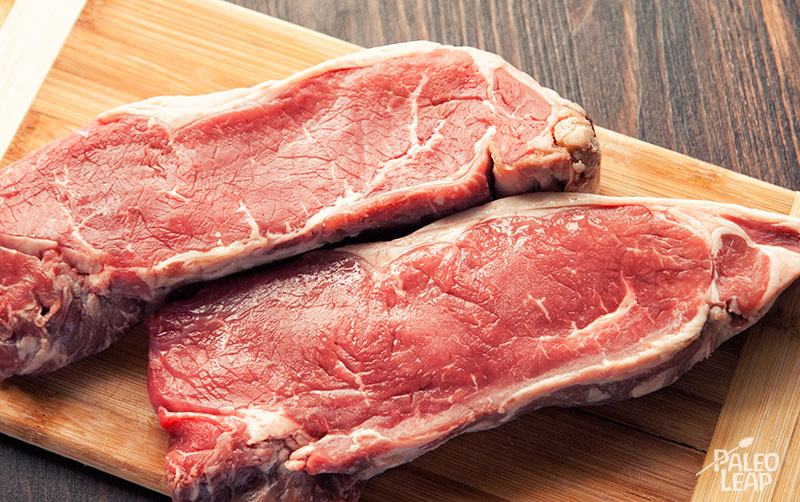
The art of cooking the perfect steak
can be intimidating for many, but it doesn’t doesn’t have to be,
because with only a few basic techniques you’re guaranteed to experience
great success every time. There is absolutely no need to go to a great
steak house to eat some of the most flavorful steaks out there, and in
fact even those restaurants often make some very fundamental mistakes
when cooking their steaks.
Another aspect that is very important for us, health savvy people, is that we obtain an end product that is not only tasty, but also health promoting.
Therefore, opting for grass-fed beef over grain-fed and choosing the
right fat to cook the steak with will not only reward you with a much
tastier steak, but also with something that you’ll know to be good for
your health.
Choosing the steak
First of all, if you really want the experience of a great steak, I urge you to choose a steak that comes from beef that has been grass-fed and grass-finished. I’d rather choose a grass-fed cut that’s less tender than a tender cut from a grain-fed animal. A great steak dinner is often a meal where you won’t want to go cheap anyway so focus on the quality of the meat and then on the quality of the cut itself.If you buy your meat from a butcher or from the grocery store and you get a chance to see what it looks like before buying it, there are a few key points to look at to get the best steak possible. It should look dry and it should also be firm to the touch. A steak that looks wet probably hasn’t aged correctly and will be less tender and less juicy when cooked. Also look for a vivid red, almost purplish, color and clear white fat marbling.
A steak is usually grated by the amount of fat marbling that is possesses. The more marbling it has, the most expensive it will be. Keep in mind though that grain-fed animals are fed a bad diet so they can quickly become very fat, but this fat will be high in omega-6, deprived of fat-soluble nutrients and often full of toxins. I would therefore look for lots of marbling, but only when it comes from an healthy animal.
If you buy a steak that comes packaged in plastic wrap, it’s a good idea to remove it from its package when storing in the refrigerator to let it breathe and dry correctly. You can put your steaks on a grid placed on a plate in the refrigerator, covered with a clean towel and it will benefit the steaks greatly.
The different cuts of steak
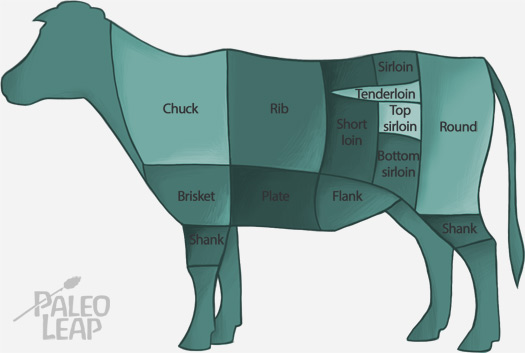
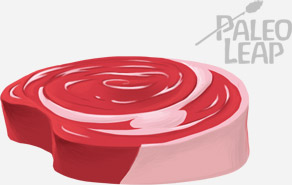 The rib eye:
The rib steak and the rib eye steak are probably the two most delicious
and prized cuts of steak available. They come from the rib region and
the rib eye is simply a rib steak without the bone. They are tender and
tasty, mainly because of the abundant marbling of fat that they have.
It’s also a really good sized steak that shouldn’t leave you hungry for
more.
The rib eye:
The rib steak and the rib eye steak are probably the two most delicious
and prized cuts of steak available. They come from the rib region and
the rib eye is simply a rib steak without the bone. They are tender and
tasty, mainly because of the abundant marbling of fat that they have.
It’s also a really good sized steak that shouldn’t leave you hungry for
more.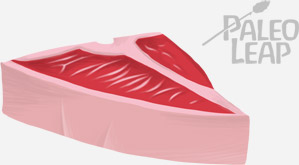 The t-bone:
The T-bone steak is probably the most well known and recognized steak
out there, mainly because the T shaped bone is quite self explanatory.
It’s a large steak well suited for hungry people and it contains two
cuts of steak in one: the strip loin and the tenderloin. The strip loin
on one side of the bone and the tenderloin on the other side. It’s a
great steak to experience the best of both worlds: the tenderness from
the tenderloin and the taste from the strip loin. T-bone steaks come
from the short loin region of the steer.
The t-bone:
The T-bone steak is probably the most well known and recognized steak
out there, mainly because the T shaped bone is quite self explanatory.
It’s a large steak well suited for hungry people and it contains two
cuts of steak in one: the strip loin and the tenderloin. The strip loin
on one side of the bone and the tenderloin on the other side. It’s a
great steak to experience the best of both worlds: the tenderness from
the tenderloin and the taste from the strip loin. T-bone steaks come
from the short loin region of the steer.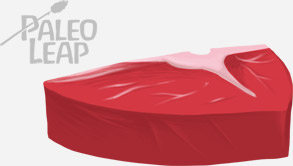 The porterhouse:
The porterhouse steak is also a large steak suited for large appetites.
It resembles the T-bone, but differs from the fact that the tenderloin
and strip loin portions are much wider. The porterhouse comes from
closer to the sirloin of the steer.
The porterhouse:
The porterhouse steak is also a large steak suited for large appetites.
It resembles the T-bone, but differs from the fact that the tenderloin
and strip loin portions are much wider. The porterhouse comes from
closer to the sirloin of the steer.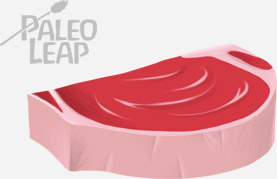 The strip loin or New York:
The strip loin or New York cut is a triangular steak found on one side
of the T-bone and is usually a very good looking, tasty and tender
steak. It’s a smaller steak than the T-bone or the porterhouse and is in
a good middle range when it comes to taste and tenderness. The picture
on the left is from a Wagyu beef that as been bred to contain much more
fat than regular beef so don’t expect this much marbling on your steak.
The strip loin or New York:
The strip loin or New York cut is a triangular steak found on one side
of the T-bone and is usually a very good looking, tasty and tender
steak. It’s a smaller steak than the T-bone or the porterhouse and is in
a good middle range when it comes to taste and tenderness. The picture
on the left is from a Wagyu beef that as been bred to contain much more
fat than regular beef so don’t expect this much marbling on your steak. The tenderloin: The
tenderloin is the most tender cut of steak you can get, but even though
it’s very tender, it’s far from being the tastiest. It’s quite lean and
it has very few fat marbling so what it gains in tenderness it looses
in taste. This is also often a much smaller steak, depending on its
thickness, than most other steaks so it’s great when the steak is not
the main attraction of the meal. It’s also a great steak to let marinate
prior to cooking to give it more taste.
The tenderloin: The
tenderloin is the most tender cut of steak you can get, but even though
it’s very tender, it’s far from being the tastiest. It’s quite lean and
it has very few fat marbling so what it gains in tenderness it looses
in taste. This is also often a much smaller steak, depending on its
thickness, than most other steaks so it’s great when the steak is not
the main attraction of the meal. It’s also a great steak to let marinate
prior to cooking to give it more taste.Prior to cooking
There are a few key steps to consider prior to cooking the steaks. First and foremost, it’s really important that you let the steaks come to room temperature before cooking them. This ensures a more even cooking process and permits the steak to spend much less time in the pan or on the grill, which will lead to a juicier steak. Simply place the steaks on a grid or on a plate and let them come to room temperature for 30 minutes to 2 hours before cooking them and it will often make a world of difference.When the time comes to finely cook the steaks, pat them dry and season them with sea salt and freshly ground black pepper. Most prime cuts of steak only need the basic salt and pepper seasoning. An elaborate use of spices would only hide their delicious flavor. Use fancy spice mixes and rubs when cooking tougher and less flavorful cuts of steak. Some people like to season their steak long before they cook it, but seasoning it just before is probably the most popular option.
The next step is to rub some melted or very soft cooking fat all over the steaks. Clarified butter, tallow, lard and coconut oil are all good options. Stay far away from olive oil when cooking steaks because you’ll be using too high of a heat for the oil, which would ultimately make it smoke, take a nasty flavor and become oxidized, a bad deal for your cells. Even lard is on the edge of being too fragile of a fat because it’s mostly composed of monounsaturated fat. If using coconut oil, keep in mind that the extra-virgin coconut oil often carries a subtle coconut taste that could be off-putting for the final result. My two favorite options are beef tallow or clarified butter. The milk ingredients in regular butter can easily burn as well so this is why clarified butter is a better option.
Cooking the steak
Grilling steak is a very popular option, especially in the summertime. On the grill, the best option is to sear the steaks on the hottest part of the grill for a few minutes on each side, turning only once to form grill marks and then finishing the steaks on the cooler part of the grill for a few more minutes, until the desired doneness is reached. Grilling though is an acquired skill that needs practice and a few mistakes to be be mastered.If you decide to go with pan frying the steaks, heat a frying pan to a very high heat. Stainless steel and cast iron pans are good choices. You’ll want to fry your steaks over a high heat so this is why I recommend rubbing the fat over the steaks instead of melting it in the hot pan prior to adding the steaks. Even highly saturated animal fats aren’t invincible to extreme heat and could smoke if placed in a pan that’s too hot for too long.
When pan frying steaks, there are two main schools of thought about the best way to proceed: the flip once method and the flip often method. Here is a short explanation of both methods:
The flip once method
This is the classic and most popular way to pan fry steaks and entails, like its name implies, flipping the steaks only once during the entire cooking process. A challenge with this method is to know when it’s time to flip the steaks. One easy way is to look for small droplets of blood that start forming on the uncooked surface of the steak. When you see those small droplets, turn the steaks with tongs and cook on the other side until they reach the desired doneness. Tongs, instead of a fork, will prevent piercing the meat and letting the juices run out.The flip often method
With this method, you’ll be flipping the steaks about every minute. This seems counter intuitive to produce a nice and brown exterior, but it does in the end lead to the desired result. The advantage of this method is that the juices will be going from one side of the steak to the other constantly, leading to an often juicier and more evenly cooked steak.Rosemary and garlic additions
Whatever the method you decide to use to cook your steaks, you can always enhance the flavors with garlic and rosemary, two items that are a perfect match with beef. While the steaks are frying or grilling, simply cut a fresh clove of garlic in half and rub the cut side all over the surface of the steaks. Then simply pat a sprig or two of fresh rosemary on the steaks. It might seem trivial to simply rub a garlic clove and pat a rosemary sprig, but those two steps really add great flavor.Determining doneness
You can always choose to be very precise and use a thermometer to determine the exact doneness, but I found that nothing beats experience and after cooking a few steaks successfully you’ll get a better feel for when they’re ready. Cutting the steaks to look at the flesh is probably not the best idea because it will let all the delicious juices run out of them.A great little trick is the hand method where you compare the feel of the steak to the feel of the thick part of your palm, just under the thumb. Press on that part while keeping an open hand and you’ll get the feel of a raw steak. Now touch your forefinger and your thumb and press the same area of your palm with a finger from your other hand and that is how a rare steak will feel. Now when you touch your middle finger and thumb, you’ll get a feel of a medium-rare steak. Finally, the ring finger gives a feel for a medium steak and the little finger gives a feel for a well done steak.
After cooking
An important, but often forgotten step when cooking a steak is to let it rest for 5 to 10 minutes after cooking it. This step is important to let the proteins relax and to let the juices stay inside the steak instead of flowing right out of it. Simply place the steaks on a cutting board or a plate and cover them very loosely with a sheet of foil with a small whole pierced on top the let the steam get out and to prevent the steaks from steaming.By resting the steaks like that, you’ll be able to collect some of the juices that run out and use those as a simple sauce for the steaks. Simply add a few drops of lemon juice and melt-in a few knobs of butter, clarified butter or tallow for a very delicious and luscious liquid to serve with the steaks. You can make another great and very quick sauce by deglazing the very hot pan you used to cook the steaks with some red wine and scraping off all the bits of meat that have stuck to the pan. Just let the liquid reduce a bit, mount it with a few knobs of your favorite fat and serve it while hot. To produce more sauce you can also add some beef stock once the pan has been deglazed with the red wine and let the liquid reduce to a thicker consistency. Adding whole peppercorns to the sauce is also a popular option.
After all this preparation finally comes the time where you can serve the steaks alongside a simple salad or a side of your favorite vegetables, steamed or roasted, and enjoy the best of what nature has to offer with your friends or family.
source
No comments:
Post a Comment